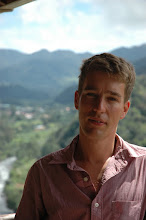Getting Into The Groove
India seduces you. The harder you look the more you are rewarded, and perhaps more worryingly, the less you notice the daily horrors and irritations that confront you in amongst all the fascination.
Of course, the experience of India can drive you spare at times. At the exceptionally preserved, deserted, Moghul city of Fatehpur Sikri, I could have punched a shop-owner who despite every discouragement stuck to my shoulder like glue throughout the entirety of my visit to the the palace mosque, advising me with unalloyed enthusiasm and bugger all knowledge on how I should be taking my photographs. All of this done in the forlorn hope that I was afterwards going to buy some overpriced junk from his miserable little shop. The fact that everybody here wants a piece of you has the perverse effect of hardening you to the constant approaches, which are therefore rarely rewarded. Only occasionally now does it ever get to me.
Nonetheless, India always has the capacity to surprise. Yesterday, the most astonishing thing happened to a couple of friends and I when driving back to our hotel in Udaipur. Approaching the fortified city gate, we spied an elephant and rider emerging through the gate and leaned out of the motor rickshaw to take shots. The driver pulled up to assist us, and then as the elephant drew level it also stopped and began tapping the rickshaw windscreen with its trunk. "It wants payment for the photo", quipped our driver, which we all thought a very good joke. Only we soon realised that it wasn't meant as a joke at all. After some hasty rummaging in pockets Graeme laid a 10 rupee note on the end of the elephant's trunk which it promptly palmed with such accomplishment you felt it must have been grafting amongst tourists for years. It really does come to something when even the elephants are on the make in this country. It's bloody lucky they haven't been successful in getting the cows trained up or we really would be going home with empty pockets.
The compensation for the irritations is the fascination of the culture and the beauty of the country and its treasures. It seemed at times in the past few days that the senses were about to overload with yet another beautiful sight. The prize of course must go to the Taj Mahal, which defied every expectation on my part that such a familiar building must surely disappoint in the flesh. It is the most sublime building I have ever seen and simply takes the breath away. We went at dawn when there were very few visitors and I was transfixed by it, wandering around and around the mausoleum with my camera for a couple of hours, watching the white marble pass through a whole gamut of colour gradations with the changing quality of the light. Simply awesome. The amazing thing is that the Taj is just one of three stunningly elegant tombs in Agra, which served as the Mughal capital for much of the dynasty's heyday.
We have seen beautifully carved Hindu temples of the 10th century in Uttar Pradesh which depict a whole karma sutra of erotic images that somehow escaped prurient destruction by later Muslim rulers of Northern India. At Orchha we camped amongst the ruins of splendid palaces and monuments at a delightful riverside spot. In Rajastan I have seen more dramatic hilltop castles than I could ever wish to in a lifetime, and now I find myself in the fantastically romantic city of Udaipur, lazing beside the lake which has filled up for the first time in 9 years after the heavy monsoon experienced by India this year. This place was the home to the greatest of the Rajput Maharaja dynasties, who used their fabulous wealth to built palace upon palace in and around the picture postcard lake. We've been tremendously lucky to see it with the lake full, and the same can be said of a marshland bird sanctuary we visited where the heavy rains have attracted literally thousands of breeding birds of every shape, size and shade of colour. I never thought being a twitcher could be so easy.
The friendliness of the people and especially the children is also a delight. Away from the touts and the young men on the make, we've been welcomed wherever we've gone. The opportunity to travel by truck has taken us to some pretty out of the way villages where I suspect our unannounced visits will prove to be one of the most talked about events in their year. In one place the whole village got up before dawn just to come and watch us take our tents down.
So India is delivering a whole cocktail of impressions and I haven't even got bored with eating three curry meals a day yet either.

